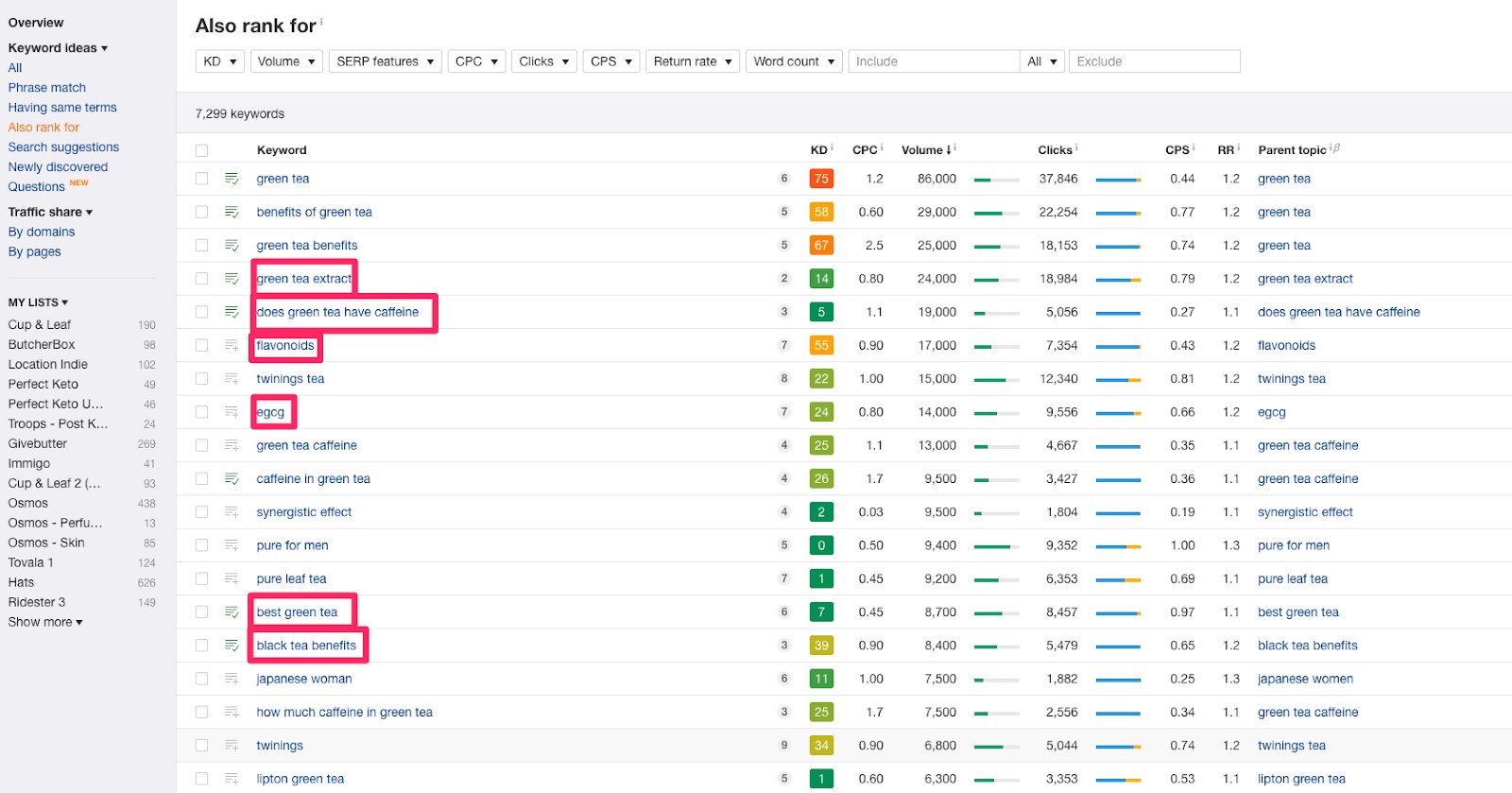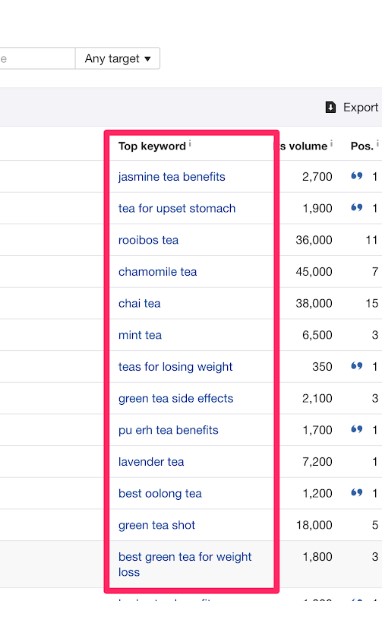Challenge
Eight months ago, our client faced the challenge of transforming their relatively obscure “Tea blog” into a thriving online resource in the fiercely competitive digital landscape. The primary obstacles were selecting a niche with significant potential, optimizing the blog for SEO, and identifying the right keywords with high traffic potential while keeping competition in check.
Solution
To address these challenges, we began by meticulously selecting the tea niche, which offered ample content opportunities and a relatively untapped market. We optimized the blog for SEO, steering clear of common pitfalls like heavyweight WordPress setups and hosting vulnerabilities. For keyword research, we employed comprehensive strategies, including the Wiki Method and the “Also Rank For” Technique, enabling us to amass a substantial pool of targeted keywords.
Results
Today, our client’s blog stands as a beacon in the tea enthusiast community, attracting over 150,000 monthly visitors. It has achieved prominent rankings on Google’s first page for numerous high-value tea-related keywords. Our content strategies, including crafting outstanding articles and leveraging various platforms for promotion, have propelled our client’s blog to unprecedented success. This case study underscores the significance of patience, stellar content, and a robust SEO approach in achieving long-term digital impact.
Full Case Study
Whenever we discuss our proficiency in SEO, the frequently asked question is, “Can you share some evidence or stories to validate your expertise?” In the past, we’d highlight the success stories of our various clients, but direct experience speaks volumes.
Around eight months ago, we embarked on a project for a client. The objective was to cultivate their “Tea blog”, from obscurity in the digital realm to a benchmark of success.
Today, That blog stands out from the regular tea blogs. It’s now a go-to site for tea enthusiasts, attracting over 150,000 visitors every month. And it doesn’t stop there; the blog sits confidently on Google’s first page for several high-value tea-related keywords.
Around eight months ago, we embarked on a project for a client. The objective was to cultivate their “Tea blog”, from obscurity in the digital realm to a benchmark of success.
Today, That blog stands out from the regular tea blogs. It’s now a go-to site for tea enthusiasts, attracting over 150,000 visitors every month. And it doesn’t stop there; the blog sits confidently on Google’s first page for several high-value tea-related keywords.


So, if you’re aiming to elevate your blog from scratch to a pinnacle, here’s how we achieved it for our client:
Choosing the Right Niche
A blog’s surge in popularity hinges on selecting the right niche. It must:
● Provide a wide array of topics to ensure continuous content.
● Attract a considerable audience searching for the content.
Setting the Blog for SEO
When guiding our clients in establishing a prominent online presence, ensuring their blog is optimized for Google search results is paramount, right after selecting a topic.
Many default to the simple route: choosing a WordPress template, hosting it on affordable platforms like BlueHost, and forging ahead. However, based on our extensive experience, we often advise against this due to several reasons:
1. As you integrate numerous plugins, WordPress can become hefty and prone to glitches.
2. Without developer skills, customization becomes a challenge.
3. Economical hosting services like BlueHost can inadvertently make your site attractive to hackers. We’ve witnessed clients fall prey to such vulnerabilities.
If you’re keen on emulating the exact approach we’ve executed for our clients, consider establishing your blog on Webflow. We also offer a comprehensive guide to ensure it’s fully optimized for SEO.
Identifying the Right Keywords
Finding a keyword that draws steady traffic without being overwhelmingly competitive is the dream. With various tools at our disposal, we scoured for keywords with high volume and low difficulty. Some effective strategies we employed included:
The Wiki Method
Using the wiki strategy, we’ve successfully guided our client’s informational website to achieve 100,000 monthly visitors in just six months. Here’s how we did it:
We started with a central theme, say “green tea,” and branched out to all possible related keywords. This includes direct topics like “green tea benefits,” and tangential ones such as “oolong tea.”
Further, we expanded to loosely related subjects like “tea steepers” or “history of tea.” With tools like Ahrefs or Google’s Keyword Planner, we assessed the potential and competition of these keywords, which helped us prioritize which ones our client should target.
The “Also Rank For” Technique
Upon gathering keyword ideas using the wiki strategy, we further enhanced our client’s content strategy. How? We used those initial keywords to uncover more related terms.
For example, when searching “green tea benefits” in Ahrefs, we delved into the “Also rank for” section. This gave us insights into other keywords that pages ranking for “green tea benefits” were also showing up for.
This method expanded our client’s keyword pool, presenting more opportunities to drive organic traffic to their site.
Choosing the Right Niche
A blog’s surge in popularity hinges on selecting the right niche. It must:
● Provide a wide array of topics to ensure continuous content.
● Attract a considerable audience searching for the content.
Setting the Blog for SEO
When guiding our clients in establishing a prominent online presence, ensuring their blog is optimized for Google search results is paramount, right after selecting a topic.
Many default to the simple route: choosing a WordPress template, hosting it on affordable platforms like BlueHost, and forging ahead. However, based on our extensive experience, we often advise against this due to several reasons:
1. As you integrate numerous plugins, WordPress can become hefty and prone to glitches.
2. Without developer skills, customization becomes a challenge.
3. Economical hosting services like BlueHost can inadvertently make your site attractive to hackers. We’ve witnessed clients fall prey to such vulnerabilities.
If you’re keen on emulating the exact approach we’ve executed for our clients, consider establishing your blog on Webflow. We also offer a comprehensive guide to ensure it’s fully optimized for SEO.
Identifying the Right Keywords
Finding a keyword that draws steady traffic without being overwhelmingly competitive is the dream. With various tools at our disposal, we scoured for keywords with high volume and low difficulty. Some effective strategies we employed included:
The Wiki Method
Using the wiki strategy, we’ve successfully guided our client’s informational website to achieve 100,000 monthly visitors in just six months. Here’s how we did it:
We started with a central theme, say “green tea,” and branched out to all possible related keywords. This includes direct topics like “green tea benefits,” and tangential ones such as “oolong tea.”
Further, we expanded to loosely related subjects like “tea steepers” or “history of tea.” With tools like Ahrefs or Google’s Keyword Planner, we assessed the potential and competition of these keywords, which helped us prioritize which ones our client should target.
The “Also Rank For” Technique
Upon gathering keyword ideas using the wiki strategy, we further enhanced our client’s content strategy. How? We used those initial keywords to uncover more related terms.
For example, when searching “green tea benefits” in Ahrefs, we delved into the “Also rank for” section. This gave us insights into other keywords that pages ranking for “green tea benefits” were also showing up for.
This method expanded our client’s keyword pool, presenting more opportunities to drive organic traffic to their site.

By scrolling through this list, We can find a bunch of new keywords We might not have thought of before, and add them to my list:

Building on the methods we used for our client: after examining the “Also rank for” terms for one keyword, we would then take other keywords from our list and repeat the process. This approach efficiently expanded our keyword opportunities.
However, if the Wiki Strategy and the “Also Rank For” Strategy don’t provide enough keywords, our next recommendation is to gain insights from competitors. Analyzing their content can unveil a wealth of potential keyword opportunities to further optimize our client’s site.
Competitor Analysis
|
To secure a top position on Google, we need to outperform existing top-ranking sites. We often recognize our client’s main competitors – those authoritative sites in their niche. Our task is to uncover the keywords driving the most traffic to these competitors. A useful tool for this is Ahrefs’ “Site Explorer,” where one can view a site’s top keywords and pages. This helps us pinpoint potential keywords for our clients to target.
Competitor Analysis
|
To secure a top position on Google, we need to outperform existing top-ranking sites. We often recognize our client’s main competitors – those authoritative sites in their niche. Our task is to uncover the keywords driving the most traffic to these competitors. A useful tool for this is Ahrefs’ “Site Explorer,” where one can view a site’s top keywords and pages. This helps us pinpoint potential keywords for our clients to target.

For our clients in the tea industry, we studied a main competitor. By examining their blog categories, we identified potential content areas to target.

Using these techniques, especially when the first two start to plateau, can be illuminating. For our clients, discovering a fresh category has often revived our initial strategies. We recommend identifying at least 50 keywords using these methods. Once armed with these, we’re set to produce impactful content for our clients.
Crafting Content that Stands Out Many can manage the initial steps with ease.
However, the challenge lies in writing. For our client, we consistently posted four quality articles weekly for eight months. Regular, quality content places you leagues ahead of most competitors.
It’s demanding, but it’s the heart of content strategy. If you’re not posting frequently, consider hiring a skilled writer. Whether you write yourself or delegate, the goal remains: produce outstanding SEO content.
Crafting the Best Outline To secure a top spot on Google, you must outperform current top-ranking articles.
While techniques like link-building can help, the essence is crafting a superior article. Enhance your content by:
● Offering more detailed information.
● Keeping your information updated.
● Making actionable points.
● Ensuring readability.
Research is key. Analyze the top 5-10 results for their covered topics, missed points, article length, and potential areas to add value. Tools like Clearscope can simplify this task, pinpointing prevalent topics among competitors.
Once you’ve gathered insights and identified improvements, you’re set to write and publish your standout piece.
Maximizing Content Exposure
One often overlooked aspect of content is its promotion. Our primary strategy involved focusing on platforms that could magnify our reach. These included:
Reddit: A goldmine for potential traffic, Reddit can skyrocket your site’s visitors overnight if leveraged correctly. Despite its unpredictability and sometimes challenging community feedback, when your content resonates, it not only boosts traffic but also enhances Google’s perception of your site’s authority.
Crafting Content that Stands Out Many can manage the initial steps with ease.
However, the challenge lies in writing. For our client, we consistently posted four quality articles weekly for eight months. Regular, quality content places you leagues ahead of most competitors.
It’s demanding, but it’s the heart of content strategy. If you’re not posting frequently, consider hiring a skilled writer. Whether you write yourself or delegate, the goal remains: produce outstanding SEO content.
Crafting the Best Outline To secure a top spot on Google, you must outperform current top-ranking articles.
While techniques like link-building can help, the essence is crafting a superior article. Enhance your content by:
● Offering more detailed information.
● Keeping your information updated.
● Making actionable points.
● Ensuring readability.
Research is key. Analyze the top 5-10 results for their covered topics, missed points, article length, and potential areas to add value. Tools like Clearscope can simplify this task, pinpointing prevalent topics among competitors.
Once you’ve gathered insights and identified improvements, you’re set to write and publish your standout piece.
Maximizing Content Exposure
One often overlooked aspect of content is its promotion. Our primary strategy involved focusing on platforms that could magnify our reach. These included:
Reddit: A goldmine for potential traffic, Reddit can skyrocket your site’s visitors overnight if leveraged correctly. Despite its unpredictability and sometimes challenging community feedback, when your content resonates, it not only boosts traffic but also enhances Google’s perception of your site’s authority.

Facebook Groups: More predictable than Reddit, these groups consistently drive smaller amounts of targeted traffic. Engaging as a genuine community member is the key. Instead of direct posts, cleverly dropping links in comments on relevant discussions can offer organic exposure without appearing spammy.
Pinterest: A unique platform where traffic grows as your presence does. As your Pinterest audience expands, more pins circulate, leading to greater visibility and resharing. While the current traffic might be modest, the visual brand representation on Pinterest offers value in attracting potential consumers.
Pinterest: A unique platform where traffic grows as your presence does. As your Pinterest audience expands, more pins circulate, leading to greater visibility and resharing. While the current traffic might be modest, the visual brand representation on Pinterest offers value in attracting potential consumers.

In addition to these platforms, backlinks remain an essential component for enhancing website visibility and credibility.
Link Building Endeavors
While our link-building efforts were subdued compared to our other strategies, they were nonetheless crucial. Some tactics we employed:
● Utilizing Owned Assets: For instance, leveraging other websites owned by the client to link back.
● Engagement through Interviews and Guest Posts..
● Capitalizing on Broken Links..
At the heart of our link-building approach was patience. As content gained traction, it began earning references and backlinks organically.
● Engagement through Interviews and Guest Posts.
● Capitalizing on Broken Links.
Link Building Endeavors
While our link-building efforts were subdued compared to our other strategies, they were nonetheless crucial. Some tactics we employed:
● Utilizing Owned Assets: For instance, leveraging other websites owned by the client to link back.
● Engagement through Interviews and Guest Posts..
● Capitalizing on Broken Links..
At the heart of our link-building approach was patience. As content gained traction, it began earning references and backlinks organically.
● Engagement through Interviews and Guest Posts.
● Capitalizing on Broken Links.
The Secret Sauce: Patience
Many falter due to insufficient content quality or impatience. For an endeavor like this to be rewarding, stellar content and patience are imperative. It’s essential to recognize that SEO’s lasting impact outdoes immediate advertising results.
Are you feeling overwhelmed by the digital currents? Dive in with confidence as our expert team leads the way in SEO-driven content marketing.Feel free to slide into our DM for detailed discussions and business growth talks.
Are you feeling overwhelmed by the digital currents? Dive in with confidence as our expert team leads the way in SEO-driven content marketing.Feel free to slide into our DM for detailed discussions and business growth talks.
